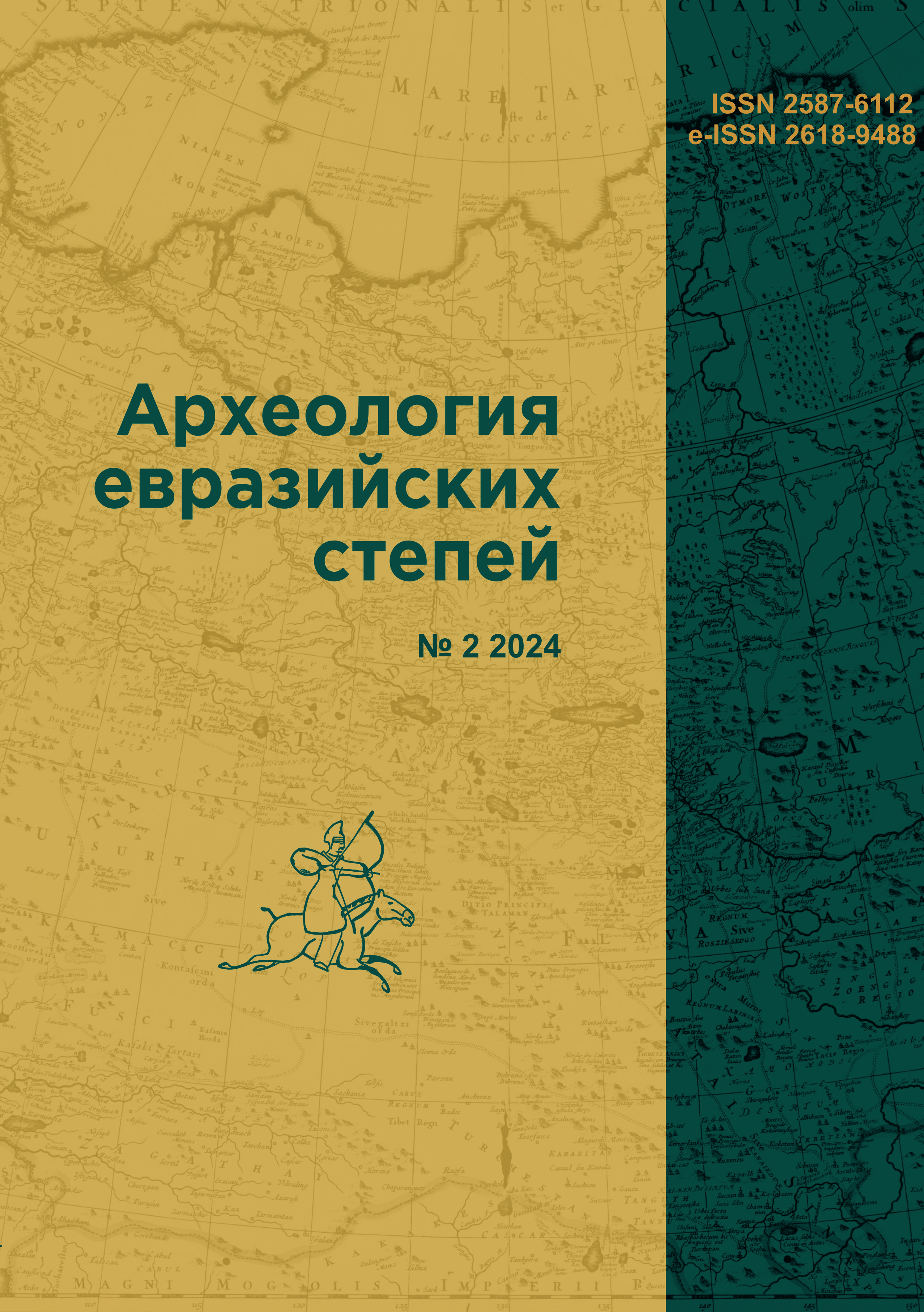STATE FORMATIONS IN ANCIENT TURKIC STEPPE SOCIETIES
DOI:
https://doi.org/10.24852/2587-6112.2024.2.193.201Keywords:
Turkic peoples, Turkic steppe societies, Turkic name, state-building, war tradition, nomadism, social stratification, töre, world state thought, centralized state mentalityAbstract
The Turks are one of the oldest nations of the world, and there is evidence that they had established states very early in their history. The masses of the Turks living a nomadic life in the steppes had formed political structures diff erent from the state systems of settled societies, and we can call these "steppe states". The most important feature of the steppe states was that they did not have fi xed centers and ruled over expansive territories using their well-trained armies. Nomadic steppe states were unions of tribes. They were established not by settled states or cities, but by the gathering of nomads who had the power of war. A family with authority to
rule ("kut" in ancient Turkic), which was received from God and could be held by legitimacy, established the state. The strength of the centralized structure depended on the ability to intervene in the remote corners of the state; otherwise, the dynamics of the steppe would bring about the rebellion of the connected tribes. The Turkic state existed in tribes formed by families connected to each other by blood kinship, and the state emerged from the tight, disciplined cooperation among these tribes. This gave the state a military character. Since the soldiers, horses and weapons were always ready for war, the expansion of the state was inevitable. Starting from the Huns until the 9th century, the center of these great states, which had a nomadic structure before Islam came onto the scene, was Ötüken, which was originally thought to be in the Orkhun Valley. After the 9th-10th centuries, Turkic states were established by Muslim horse warriors who combined urban and nomadic steppe traditions, making rich trade networks their political centers.
References
Beckwith, Christopher I. 2009. Empıres Of The Silk Road A History of Central Eurasia from the Bronze Age to the Present, Princeton and Oxford: Princeton University.
Bıçak, Ayhan. 2019. Türk Düşüncesi I Kökenler, İstanbul: Dergâh.
Bıçak, Ayhan. 2020. Devlet Felsefesi Eleştiriler ve Öngörüler, İstanbul: Dergâh.
Cezar, Mustafa. 1977. Anadolu Öncesi Türklerde Şehir ve Mimarlık, İstanbul: İş Bankası.
Danilov, S. V. 2004. Goroda v Koçevıh Obşçestvah Tsentralnoy Azii, Ulan-Ude.
Donuk, Abdülkadir. 1990. Türk Hükümdarı, İstanbul, Türk Dünyası Araştırmaları.
Eberhard, W. 2008. “Orta Asya Göçebe Kavimlerinde Devlet Kurma Süreci”, Trans., O. G. Özgüdenli, Türk Kültürü İncelemeleri Dergisi, 18, 1-8.
El-Cahiz Ebu Osman Amr b. Bahr. 1967. Hilâfet Ordusunun Menkıbeleri ve Türklerin Fazîletleri, çev. Ramazan Şeşen, Ankara: Türk Kültürünü Araştırma Enstitüsü.
Ergin, Muharrem. 2009. Orhun Abideleri, İstanbul: Boğaziçi.
Gökalp, Ziya. 1975. Türk Töresi, İstanbul: Türk Kültür.
Han Shu, 1997. Beijing: Zhonghua Shuju.
İnan, Abdülkadir. 1998. Makaleler ve İncelemeler, I, Türk Tarih Kurumu: Ankara.
Jiu Tang Shu. 1997. Beijing: Zhonghua Shuju.
Kafesoğlu, İbrahim. 2004. Türk Milli Kültürü, İstanbul: Ötüken.
Kafesoğlu, İbrahim. 2014. Umumî Türk Tarihi Hakkında Tespitler, Görüşler, Mülâhazalar, İstanbul: Ötüken.
Kâşgarlı Mahmud. 2006. Divanü Lûgat-it-Türk, I, trans. Besim Atalay, Ankara: Türk Dil Kurumu.
Kâşgarlı Mahmud. 2018. Dîvânu Lugâti’t-Türk, Haz. A. B. Ercilasun-Z. Akkoyunlu, Ankara: Türk Dil Kurumu.
Mardin, Ş. 2004. “Tabakalaşmanın Tarihsel Belirleyicileri: Türkiye’de Toplumsal Sınıf ve Sınıf Bilinci”, Türkiye’de Toplum ve Siyaset Makaleler 1, ed. M. Türnöke, İstanbul: İletişim.
Ögel, Bahaeddin. 2000., Türk Kültür Tarihine Giriş, I, Ankara: Kültür Bakanlığı.
Ögel, Bahaeddin. 1989. Türk Mitolojisi, I, Ankara: Türk Tarih Kurumu.
Ögel, Bahaeddin. 2001., Dünden Bugüne Türk Kültürünün Gelişme Çağları, İstanbul: Türk Dünyası Araştırmaları Vakfı.
Ögel, Bahaeddin. 2003. İslâmiyetten Önce Türk Kültür Tarihi, Ankara: Türk Tarih Kurumu.
Ögel, Bahaeddin. 2016. Türklerde Devlet Anlayışı, İstanbul: Ötüken.
Soysal, M. O. 2002., Eski Türk Edebiyatı Metinleri, Ankara: Milli Eğitim Bakanlığı.
Sümer, F. 1960. “Oğuzlara Ait Destani Mahiyette Eserler”, Dil ve Tarih Coğrafya Dergisi, XVII/3-4, 359-455.
Türkdoğan, Orhan. 1981. “Türk Toplumunda Sanayinin Gelişimi”, Milli Eğitim ve Kültür, 6, 16-29.
Xin Tang Shu. 1997. Beijing: Zhonghua Shuju.
Yıldırım, Kürşat. 2017. Bir Zamanlar Türk İdiler Türk Kökenli Çin Aileleri, İstanbul: Ötüken.
Yıldırım, Kürşat. 2020. "Devlet Aklı Bakımından Bilge Tonyukuk", Tonyukuk Kitabı, ed. Kürşat Yıldırım, İstanbul: Türk Ocakları, 381-387.
Yıldırım, Kürşat. 2023. "Eski Türklerde Şehir Yapısı ve Kültürü Üzerine Bazı Değerlendirmeler", Avrasya İncelemeleri Dergisi, XII/1, 81-89.
Downloads
Published
How to Cite
Issue
Section
License
Copyright (c) 2024 Yıldırım Kürşat, Yıldırım Elvin

This work is licensed under a Creative Commons Attribution-NonCommercial 4.0 International License.








